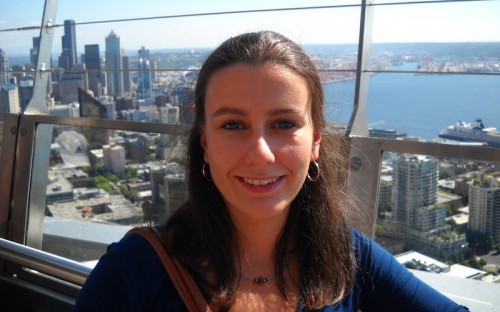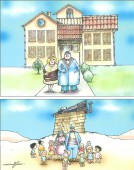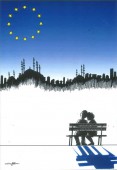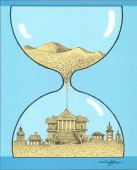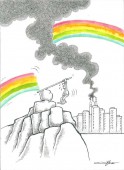Deniz Cil on Atila Özer, Cartoons, and Free Speech in Turkey
by Olivia Stransky / March 22, 2013 / No comments
Deniz Cil, managing editor of the Journal of Conflict Resolution, came to Pittsburgh in February 2013 to present the work of her uncle, Turkish cartoonist Atila Özer, which was being showcased at the Toonseum, a cartoon museum in Pittsburgh’s Downtown. Özer passed away in 2011; however, his legacy is being maintained by his wife, Vicdan Bulunmaz Özer, and his niece through the Atila Özer Cartoon House. See a slideshow of Atila Özer’s work here.
Cil, who is currently working on her Ph.D. at the University of Maryland, met with Sampsonia Way at the Toonseum. Surrounded by her uncle’s art, she talked about Özer’s transition from engineer to cartoonist, Turkey’s controversial Ergenekon trials, and what topics are taboo for Turkish cartoonists.
Your uncle originally studied to be an engineer. What made him switch to cartoons?
When he was growing up, the barbershop had comic books for people in line to read, so if there was a line he was very happy. He would wait in line for an hour just to read all those comic books and then leave without getting a haircut! Every week he did the same thing. He always wanted to be a cartoonist, but when he was 20, his family didn’t think he could make a living that way, so they wanted him to be an engineer. He actually worked as an engineer for several years. Then after working in engineering for a while, he decided, “I’m going to be an artist.” So he enrolled in a graduate program in Communication Arts and later founded and directed the Anadolu University Cartoon Art Research Center and the Anadolu Cartoon Art Museum, which he worked with until his death.
“In some ways, Turkey is a lot more progressive than the United States when it comes to cartoonists.”
Did he ever face censorship as a cartoonist?
I don’t know if he encountered any censorship when he was publishing in Turkey. A lot of his drawings were for local magazines which might not be as contentious as working for a national newspaper. He was also published in national newspapers, but I was very young at the time and don’t remember if he faced any censorship from that. He won a lot of international awards with cartoons dealing with very contentious issues like religion, peace, and human rights. But those were international competitions which are safer for discussing those issues.
However, just few years ago, Musa Kart was put in jail because of a cartoon he drew where he portrayed the Turkish Prime Minister as a cat tangled up in the yarn of domestic issues. So there definitely are free speech issues for cartoonists in Turkey, but I don’t think my uncle faced any.
What do you think is the most taboo topic to touch on in Turkey today?
I think that would be religion. Turkey is becoming more religious than it used to be, and there has been a changing dynamic in the last twelve years in government policies during the Justice and Development Party’s incumbency.
What about Law 5816 forbidding insults against Mustafa Kemal Atatürk and Article 301 against insulting Turkey, the Turkish ethnicity, or Turkish government institutions?
That’s the other side of censorship in Turkey. If you don’t show Turkish official figures as we are used to seeing them, then people get upset. There was a film in 2008 about Atatürk’s life, Mustafa, and it focused more on his relationship with his wife than his political achievements. People found that degrading. Recently a writer was facing prison time because of a graphic novel he wrote, Genç Mustafa, in which he shows a young Atatürk being beaten up.
In the past 12 years, the number of jailed journalists in Turkey has risen dramatically. The Committee to Protect Journalists rated it Number One for 2012 as the worst jailer of the press. What is causing this increase?
There is a very controversial case regarding an alleged coup d’etat which has caused several trials, referred to as the “Ergenekon trials,” which started in 2007. In 2008 there were big waves of arrests every month. Of course the distribution of who is going to jail is very skewed—people who are with an opposition party or who have opposing views to the ruling party. There is a lot of suspicion from the public in regards to the credibility of the judicial process. Several cases are lumped together under one big case and there is an enormous number of different people under arrest for various charges who have been waiting for a trial for a long time. The large amount of journalists in prison is largely the result of the Ergenekon trials.
Is that causing more self-censorship in the press?
Yes, I think so. It’s very difficult to prove that, though, because whatever you see in the newspaper is getting self-selected by the journalist and then decided on by the editors, so it’s hard to be certain. However I believe that if you talked to an editor or journalist, you would find out that there’s a lot of self-censorship going on.
Is that affecting cartoonists as well?
After what happened to Musa Kart, I think editorial cartoonists have become more careful. There was a big public reaction to his arrest, and I believe everyone started self-censoring.
However, in some ways, Turkey is a lot more progressive than the United States when it comes to cartoonists. Many of the cartoon museums in Turkey are funded and supported by their local governments and by universities. Political cartoons are mostly respected and seen as an important part of Turkish art.
See a slideshow of Atila Özer’s work here.

